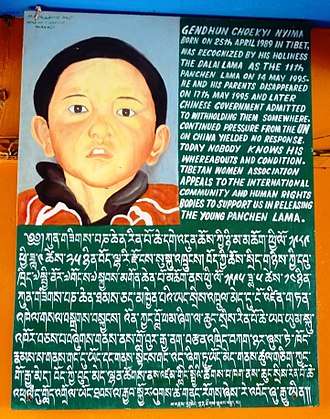11th Panchen Lama controversy
The 11th Panchen Lama controversy is a dispute about the current legitimate holder of the Panchen Lama title, a political and religious leadership position in Tibet and Tibetan Buddhism. After the death of the 10th Panchen Lama, a dispute between the Chinese leadership and the exiled 14th Dalai Lama resulted in two competing candidates. The search committee process involving monks in Tibet under the strict supervision of the Chinese communist regime was disrupted when the Dalai Lama, according to the Tibetan tradition, unilaterally announced his selection of Gedhun Choekyi Nyima. The leadership in China spirited Nyima away to prevent his being taken to India by the Dalai Lama's supporters and reverted to the Qing Dynasty's Golden Urn process to select Gyaincain Norbu, who currently fulfills the duties of the Panchen Lama in China.
Selection of the Panchen Lama
Three days after the death of the 10th Panchen Lama, the Premier of the State Council published decision on how the 11th Panchen Lama would be selected based on the feedback gathered from the committee of Tashi Lhunpo Monastery and monks on January 30th 1989. [1][2][3]
Five years after the death of the 10th Panchen Lama, ordinarily, the 11th Panchen Lama would have already been identified.[4] The Nechung Oracle in Dharamsala had been consulted on the matter.[5]
Tibetans would not consider a candidate for the eleventh incarnation legitimate unless he were identified according to Tibetan traditional means, including a search by the tenth's senior staff based on dreams and omens, and formal recognition of the result by the Dalai Lama. On the other hand, the leaders of the Chinese government wanted the process to demonstrate their authority. Beijing planned to have the traditional group of monks follow traditional methods, but to identify a group of candidates, not only one, and then to use the Golden Urn to randomly select one of them, and to exclude the Dalai Lama from the process altogether.[6]
However, Beijing later allowed Tashilhunpo Monastery's Chadrel Rinpoche, the head of the search team, to communicate with the Dalai Lama, currently exiled and an opponent of the regime, in hopes that a mutually acceptable process and candidate could be accomplished. At the end of 1994, twenty-five candidates had been identified, and Chadrel sent the Dalai Lama detailed information on all of them; but Chadrel also wrote that all signs pointed to Gedhun Choekyi Nyima as the true reincarnation. In February 1995, the Dalai Lama replied to Chadrel that his own divinations confirmed Gedhun Choekyi Nyima. Chadrel intended to publicly mimic the process that occurred in identifying the tenth Panchen Lama in 1949: the urn would not be used; China would be first to publicly name the choice; and then the Dalai Lama would confirm it. However, in March 1995, Chinese officials insisted on drawing a name from three to five slips in the urn. On May 14, 1995, the Dalai Lama preempted the drawing by publicly announcing that Gedhun Choekyi Nyima was the eleventh Panchen Lama.[7]
In November 1995, the Chinese government selected a different boy, Gyaincain Norbu, using the Golden Urn. This decision was immediately denounced by the Dalai Lama. China holds Gedhun Choekyi Nyima in a place whose location has not been divulged to the public.[8]

In May 1997, Chadrel was sentenced to six years in prison for splittism and betraying state secrets.[9]
Notes
References
- Goldstein, Melvyn C. The Snow Lion and the Dragon: China, Tibet, and the Dalai Lama (1997) University of California Press. ISBN 0-520-21951-1
- Hilton, Elizabeth. The Search for the Panchen Lama (2000) W. W. Norton & Company. ISBN 0-393-04969-8
- Kuzmin S.L. Management as a tool of destruction. Reincarnation of "Living Buddhas" in modern Chinese legislation. – The Tibet Journal, vol. 42, no 1, pp. 37-48.